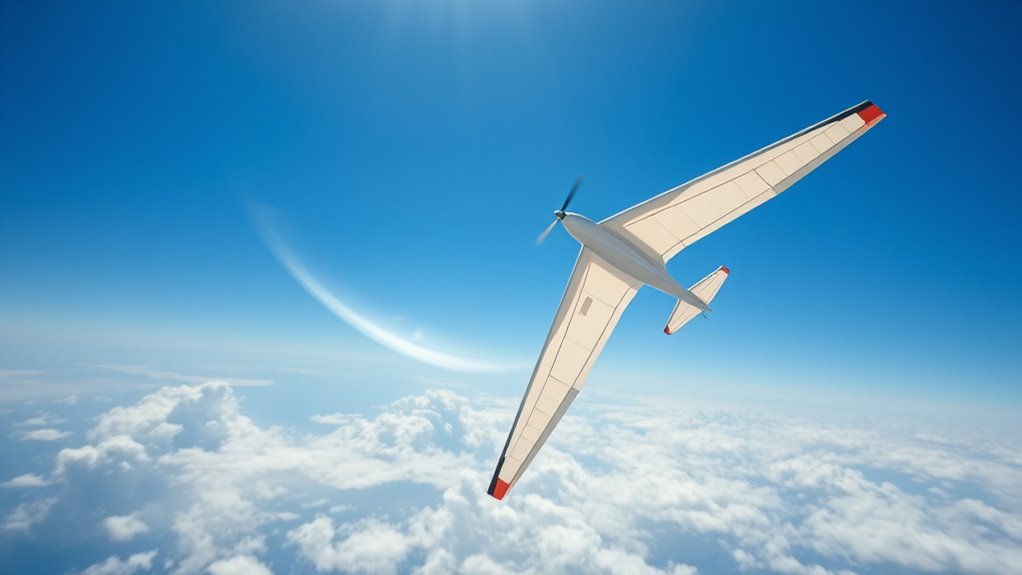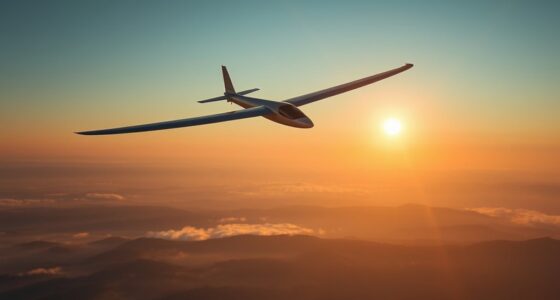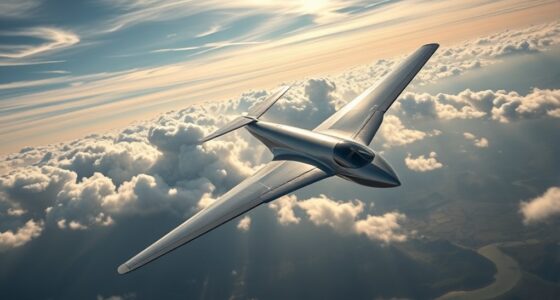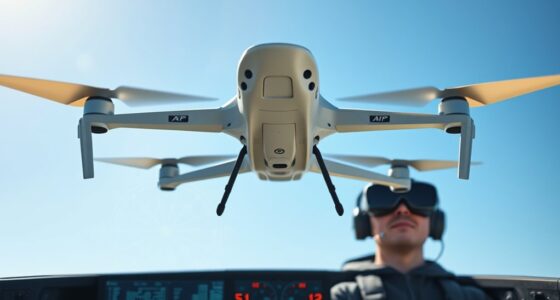To optimize your thermal climbing rate, you should adjust your bank angle and circling speed based on thermal strength and size. Steeper bank angles help tighten your turns, keeping you within the thermal core, but they raise your descent rate if not managed carefully. Faster circling speeds can improve lift capture in strong thermals, while shallower banks work better in weak conditions. Balancing these factors guarantees maximum climb efficiency—stick with the strategies outlined, and you’ll master this balancing act.
Key Takeaways
- Increasing bank angle tightens turns, improving thermal centering but raises descent rate if not balanced with speed.
- Higher circling speed helps stay in weak thermals but may reduce turn tightness and thermal coverage.
- Maintaining an optimal balance between bank angle and circling speed maximizes climb rate and thermal efficiency.
- Strong thermals benefit from steeper banks and faster circling, while weak thermals require shallower banks and slower speeds.
- Precise control of bank angle and speed prevents stalls and conserves energy for sustained thermal ascent.
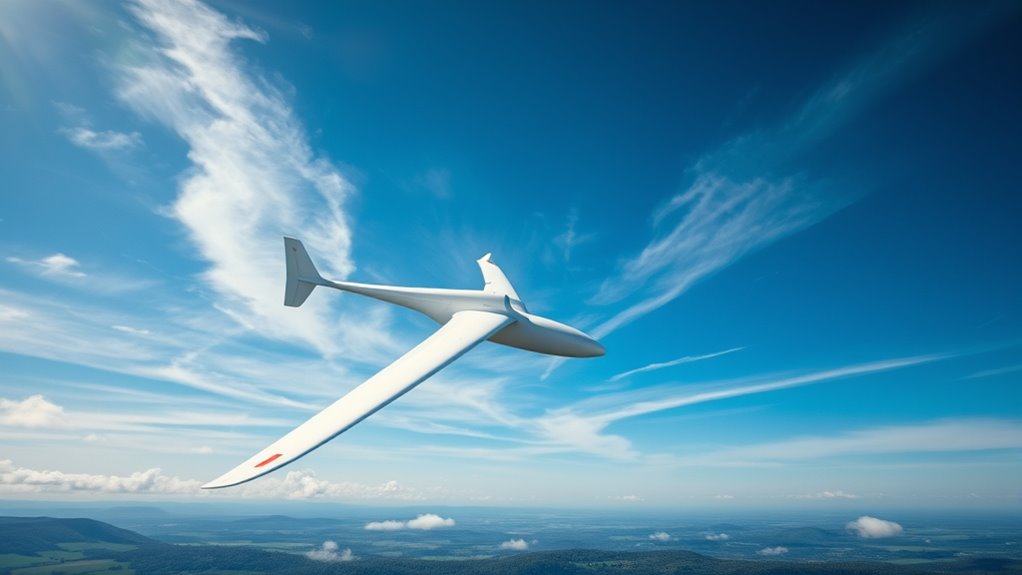
Optimizing your climbing rate is vital for maximizing efficiency and conserving energy during your ascent. When thermal soaring, your goal is to gain altitude with minimal effort, and understanding how to balance bank angle and circling speed plays a key role. The glide ratio, which measures how far you can travel horizontally for each unit of altitude lost, directly influences your ability to stay within the thermal’s core and maximize your climb. A high glide ratio allows you to circle more efficiently, covering less distance while gaining altitude. Conversely, a lower glide ratio means you need to be more precise with your circling pattern to avoid drifting out of the thermal.
Your stall speed, the minimum airspeed needed to maintain controlled flight, also influences your thermal climbing strategy. Staying above stall speed ensures you maintain control and avoid dangerous situations. When you increase your bank angle to tighten your circling radius, your airspeed naturally decreases, approaching stall speed if you’re not careful. This makes understanding the stall speed critical, as flying too slow risks losing control, while flying too fast reduces your ability to circle tightly within the thermal. Striking a balance between bank angle and circling speed is key to optimizing your ascent.
Bank angle affects your circling speed considerably. A steeper bank angle causes a tighter turn, which can keep you centered in the thermal but also increases your rate of descent if not managed properly. It can help you stay within the core of the thermal, especially if the thermal is small or turbulent. However, the trade-off is that a steeper bank reduces your glide ratio and increases your stall risk if you decrease your airspeed too much. A shallower bank angle results in a larger turn radius and a higher circling speed, which might make it easier to maintain a safe speed above stall but could cause you to drift outside the thermal’s core more easily.
Finding the ideal combination involves continuously adjusting your bank angle and circling speed based on the thermal’s strength and size. When thermal conditions are weak, a shallower bank and higher circling speed help conserve energy and maintain control. In stronger thermals, a steeper bank and tighter turn can help you stay within the rising air and maximize your climb rate. The goal is to keep your airspeed safely above stall speed at all times, ensuring you remain in control while optimizing your glide ratio for the best ascent. Additionally, understanding how market research can help you identify the most effective strategies will further improve your thermal soaring efficiency. By fine-tuning these parameters, you’ll improve your thermal soaring efficiency and elevate your overall flying performance.
Frequently Asked Questions
How Does Altitude Affect Optimal Bank Angle?
Altitude effects mean you need to make bank angle adjustments as you climb. Higher altitudes have thinner air, which reduces lift, so you should diminish your bank angle to maintain control and efficiency. Conversely, at lower altitudes, a steeper bank might be beneficial. Always monitor your aircraft’s response and adjust your bank angle accordingly to optimize thermal climbing rates and ensure safe, effective circling.
What Role Does Aircraft Weight Play in Circling Speed?
Your aircraft’s weight impacts circling speed because a heavier load increases stall speed and requires more energy to maintain altitude. As a result, you’ll need to fly at a higher speed to stay safely within lift limits. Load considerations are vital; you should adjust your circling speed accordingly to guarantee safe maneuvering and peak performance, especially when dealing with varying weights during thermal climbs.
Can Weather Conditions Modify Ideal Climbing Parameters?
Weather impact definitely influences your climbing parameters, making the ideal settings a moving target. Wind influence can push you off course, requiring adjustments in bank angle and circling speed. Turbulence may demand a more cautious approach, while thermal activity can be harnessed for better lift. So, stay alert to changing conditions, adapt your technique, and guarantee your climb remains efficient despite the weather’s unpredictable effects.
How Do Pilot Experience Levels Influence Decision-Making?
Your experience level substantially influences your decision-making, as increased pilot confidence helps you make quicker, more accurate choices during thermal climbs. Conversely, less experienced pilots may face decision fatigue, leading to hesitation or errors. With experience, you better judge ideal bank angles and circling speeds, reducing risks. Confidence grows with practice, enabling you to adapt to changing conditions and maintain safety and efficiency during thermal soaring.
Are There Differences in Optimization for Different Aircraft Types?
Yes, you’ll notice differences in optimization based on aircraft design and control systems. For example, lightweight gliders optimize thermal climbs with higher bank angles and specific circling speeds, while powered aircraft with advanced control systems can maintain more efficient patterns at different angles. Understanding your aircraft’s design helps you adjust bank angles and circling speeds effectively, maximizing climb rate and safety during thermal soaring.
Conclusion
By adjusting your bank angle and circling speed, you can considerably boost your thermal climbing rate. For example, flying at the ideal circling speed can increase your climb efficiency by up to 15%. Remember, small adjustments make a big difference—so experiment with different bank angles to find what works best for you. Mastering these techniques could be the key to soaring higher and longer, maximizing your time in the sky and improving your overall flight performance.
